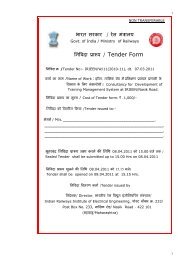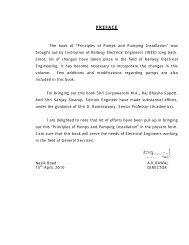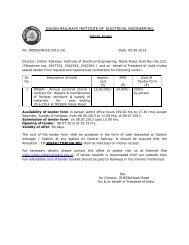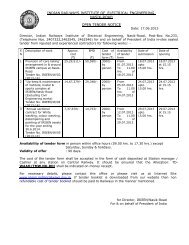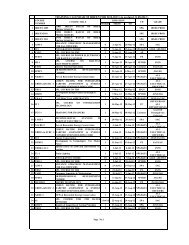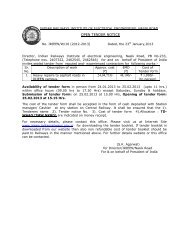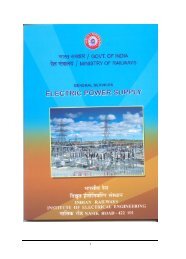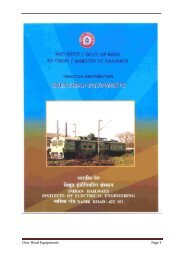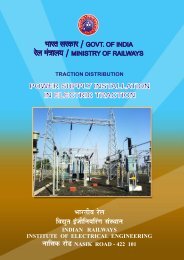Traction Rolling Stock - Indian Railways Institute of Electrical ...
Traction Rolling Stock - Indian Railways Institute of Electrical ...
Traction Rolling Stock - Indian Railways Institute of Electrical ...
You also want an ePaper? Increase the reach of your titles
YUMPU automatically turns print PDFs into web optimized ePapers that Google loves.
is run to maintain vacuum in the system. Two exhausters can also be operated, if necessary.<br />
Exhausters (Bl) create vacuum in the VTP through VA-lB control valve (BG). When A9<br />
drivers automatic brake valve (A12) is placed in "release" position, the vacuum in the exhauster is<br />
limited by two vacuum relief valves (B5) set at 60 cms max. with hose pipe on dummy with 8 mm<br />
leak hole. Exhausters are protected against ingress <strong>of</strong> dirt and dust by GD80H (B3) type oil bath<br />
filters. Leakage <strong>of</strong> atmospheric air through the idle exhauster is avoided by non-return valve (B4).<br />
Vacuum relief valves in the exhauster line protect the exhausters against high vacuum when the<br />
VA-1B control valve is the disconnected from train pipe during brake application. The desired<br />
vacuum in the VTP during release position is controlled by the HS4 control air valve (B7). In<br />
release position <strong>of</strong> the automatic brake valve A9 (A13), VA-1B control valve (B6) is actuated by the<br />
air brake pipe pressure and the control valve piston is moved down to connect the exhauster to the<br />
VTP.<br />
7.2.5. Operation <strong>of</strong> brakes on trailing stock equipped with air brake equipment.<br />
(Ref. fig.7.2.5)<br />
In release position <strong>of</strong> A9 automatic brake valve (A13), main reservoir air flows to the<br />
regulating portion <strong>of</strong> automatic brake valve at a pre-determined pressure, normally 5 kg/cm2. The<br />
regulated air pressure flows through MU-2B valve (A54) to the control port2 <strong>of</strong> addl. C2 relay valve<br />
(A29). This control pressure actuates C2 relay valve (A29) which in turn connects main reservoir to<br />
brake pipe and charges the brake pipe and the connected system to the same pressure level<br />
throughout the train. Any leakage in the train system is automatically compensated by the add. C2<br />
relay valve.<br />
When the automatic brake valve handle A9 is moved to minimum reduction position,<br />
reduction <strong>of</strong> pressure in brake pipe by 0.2 to 0.5 kg/cm² is achieved and proportional application <strong>of</strong><br />
brakes on loco and trains take place. In full service position <strong>of</strong> the automatic brake valve handle,<br />
the BP pressure is reduced to 3.5 kg/cm².<br />
When the A9 automatic brake valve handle is placed in emergency position, the<br />
emergency cam dog <strong>of</strong> A9 is actuated to vent brake pipe pressure at a very fast rate to<br />
atmosphere to initiate an emergency brake application. Regression <strong>of</strong> power also takes place due<br />
to the actuation <strong>of</strong> H-5 relay air valve (fig 7.2.4). Reduction in pressure in the brake pipe actuates<br />
the distributor valve on the loco and trailing stock to apply brakes.<br />
The C3W distributor valve provided in the brake circuit, is connected to the brake pipe<br />
and responds to the variations <strong>of</strong> pressure in the brake pipe. It applies proportionate brake<br />
application on locomotive when train brakes are applied either through automatic or emergency<br />
brake valve. The C3W distributor has a in built Goods/Passenger changeover cock to regulate<br />
brake cylinder pressure depending on whether it is hauling passenger or freight train.<br />
32 mm feed pipe through-out the train in charged from the first two main reservoirs,<br />
through check valve and feed valve at 6.0 ± 0.1 kg/cm² and is used for filling auxiliary reservoirs <strong>of</strong><br />
the trailing stock initially as well as after the air from these reservoirs had been consumed during<br />
braking. The main advantage <strong>of</strong> this additional pipe is to reduce the release and recharging time <strong>of</strong><br />
the train after brake application.<br />
7.2.6 Operation <strong>of</strong> brakes on trailing stock equipped with vacuum brake equipment.<br />
(Ref. fig. 7.2.4)<br />
In release position <strong>of</strong> the automatic brake valve (A9) handle, the brake pipe is charged<br />
to 5.0 kg/cm² and vacuum in vacuum train pipe (VTP) is created through VA-1B control valve.




